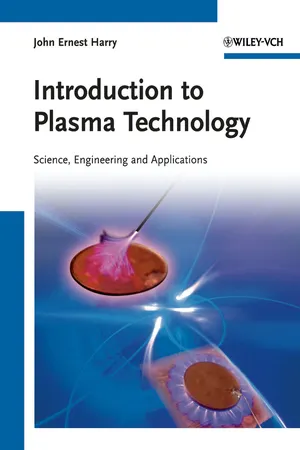
Introduction to Plasma Technology
Science, Engineering, and Applications
- English
- ePUB (mobile friendly)
- Available on iOS & Android
About This Book
Written by a university lecturer with more than forty years experience in plasma technology, this book adopts a didactic approach in its coverage of the theory, engineering and applications of technological plasmas.
The theory is developed in a unified way to enable brevity and clarity, providing readers with the necessary background to assess the factors that affect the behavior of plasmas under different operating conditions. The major part of the book is devoted to the applications of plasma technology and their accompanying engineering aspects, classified by the various pressure and density regimes at which plasmas can be produced. Two chapters on plasma power supplies round off the book.
With its broad range of topics, from low to high pressure plasmas, from characterization to modeling, and from materials to components, this is suitable for advanced undergraduates, postgraduates and professionals in the field.
Frequently asked questions
Information
| Low-pressure non-equilibrium plasma | Atmospheric non-equilibrium plasmas | High-current equilibrium plasmas |
| Plasma processes used in electronics fabrication Glow discharge diode Magnetron Induction coupled plasmas Electron cyclotron resonance reactor Helical reactor Helicon reactor Low-pressure electric discharge and plasma Lamps Low-pressure mercury vapour lamp Cold cathode low-pressure lamps Electrodeless low-pressure discharge lamps Plasma display panels Gas lasers Free electron and ion beams Electron and ion beam evaporation Ion beam processes High-power electron beams Glow discharge surface treatment Propulsion in space | Atmospheric pressure discharges Corona discharges Corona discharges on power lines Electrostatic charging processes Electrostatic precipitators Electrostatic deposition Dielectric barrier discharges Manufacture of ozone Surface treatment using barrier discharges Partial discharges Surface discharges Atmospheric pressure glow discharges Surface treatment of films and textiles to change surface properties Sterilization of medical equipment and disinfection Surgery Diesel exhaust treatment Biomedical applications Surface modification to improve adhesion, hydrophobic properties, wetting | Arc welding Metal inert gas welding Tungsten inert gas welding Submerged arc welding Plasma torch Electric arc melting Three-phase AC arc furnace DC arc furnaces Electric arc smelting Plasma melting furnaces Vacuum arc furnaces Arc gas heaters Electric discharge augmented fuel flames Induction coupled arc discharges High-pressure discharge lamps Ion lasers Arc interrupters Vacuum circuit breakers and contactors Magnetoplasmadynamic power generation Generation of electricity by nuclear fusion Natural phenomena Lightning Applications in space |
| Low-temperature thermal cold plasmas | Low-temperature non-thermal cold plasmas | High-temperature hot plasmas |
| Te ≈ Ti ≈ T < 2 × 104 K | Ti ≈ T ≈ 300 K Ti  | Ti ≈ Te > 106 K |
| Arcs at 100 kPa | Low pressure ∼100 Pa glow and arc | Kinetic plasmas, fusion plasmas |
| From Ref. [1]. | ||


Table of contents
- Cover
- Half Title page
- Related Titles
- Title page
- Copyright page
- Preface
- Symbols, Constants and Electronic Symbols
- Chapter 1: Plasma, an Overview
- Chapter 2: Elastic and Inelastic Collision Processes in Weakly Ionized Gases
- Chapter 3: The Interaction of Electromagnetic Fields with Plasmas
- Chapter 4: Coupling Processes
- Chapter 5: Applications of Nonequilibrium Cold Low-pressure Discharges and Plasmas
- Chapter 6: Nonequilibrium Atmospheric Pressure Discharges and Plasmas
- Chapter 7: Plasmas in Charge and Thermal Equilibrium; Arc Processes
- Chapter 8: Diagnostic Methods
- Chapter 9: Matching, Resonance and Stability
- Chapter 10: Plasma Power Supplies
- Index